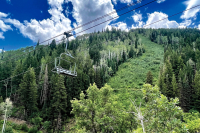Christmas in Appalachia
As the temperature drops in Western North Carolina, the fun only heats up. The holiday season here is filled with events and activities aimed to celebrate the best way we know how — with friends, family and visitors alike.
A love letter to Appalachia
Editor’s note: This article first appeared online at the website “100 Days in Appalachia.” Meredith McCarroll is from Waynesville, went to Appalachian State and the University of Tennessee and resides in Brunswick, Maine. She is author of “Unwhite: Appalachia, Race, and Film” and co-editor of “Appalachian Reckoning: A Region Responds to Hillbilly Elegy.”
Lost and found in the woods of Appalachia
Another regional writer has just published a new book. Janisse Ray, whom I know as an original member of the Southern Nature Project (www.southernnature.org) and author of “Ecology of a Cracker Childhood,” is winner of many major national literary awards as well as being inducted as a member of the Georgia Literary Hall of Fame. A Georgia native, she is a neighbor of ours here in the Southern Appalachians, which is where her new book and her first novel takes place.
Can’t believe what’s happening to my hometown
Change is difficult for most people. Watching my humble hometown turn into an unrecognizable place is a hard pill to swallow.
An A.T. alternative: Long-distance trail under construction for the western Appalachians
As the Appalachian wilderness trail Benton MacKaye dreamed up in 1921 becomes busier and busier, a geographically scattered group of trail enthusiasts is building an alternative — the Great Eastern Trail , a 1,800-mile route stretching from Alabama to New York.
JAM program gives students sense of place
There is a special moment that happens whilst playing music, a moment when concentration takes over as a musician uses both hands in a complicated way on their instrument or tunes into harmony with another voice. It is a moment when nothing else exists. All of a sudden it is only the musician and the sounds that are being created. Despite anything and everything else that may be challenging or distracting, in that moment it all disappears.
Folkmoot ‘Mountain Memories’ series
Folkmoot is proud to partner with the Mountain Memories organization and Waynesville’s own Bob Plott to launch the Mountain Memories performance series at historic Queen Auditorium on the Folkmoot campus.
The series opens with “Mountain Memories No. 1: A Hazelwood Gathering” at Saturday, Nov. 16, at the Folkmoot Friendship Center in Waynesville. Doors open at 6 p.m. with food and beverages available in the cafeteria. The “Mountain Memories” show starts at 7 p.m. in the auditorium.
The untold story: Smokies seeks to showcase history of African-Americans in the park
Many plotlines weave through the story of the Great Smoky Mountains National Park, but if the park were a book, some of those plotlines be written in bold, with others buried in small type.
“We probably go overboard in telling the story of the white Appalachian settlers to this area,” said Susan Sachs, the park’s acting chief of resource education. “We do a better job of telling the stories of the Cherokee, but there’s still a lot of room for improvement. But then when it comes to the African-American story, we know that we are failing there.”
The story behind the man: First-ever Horace Kephart biography explores a complex man and momentous life
Horace Kephart has been dead for 88 years, but his name and his story still pull an undercurrent through Western North Carolina.
Kephart is acclaimed as the father of the Great Smoky Mountains National Park, an outdoorsman gifted with an adventurous soul, and the author of such staples of regional literature as Our Southern Highlanders and Camping and Woodcraft. He’s derided, too, as a man with a severe drinking problem, a shirker of family responsibility and an outsider who profited off of sometimes less-than-flattering depictions of the locals.
Book examines change in rural Appalachia
In the last 75 years, the landscape and the culture of the Appalachian South have undergone enormous change.
Take the town in which I live. Just 16 years ago, this town offered two large grocery stores, a K-Mart, and of course numerous other small, family-owned shops. That was the extent of choices for shoppers. The nearby motels wore that look of seedy disrepair found in so many such establishments built in the 1950s. The town boosted 10 Seven-Elevens, but had few restaurants other than the usual fast food places. By their dress and accents, many of the people in the stores and on the streets were easily identifiable as natives, born and bred in these hills.













